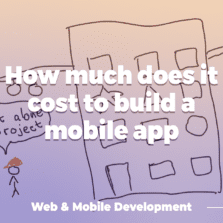

Non-fungible token (NFT) blockchain games are creating a furor in the financial market at the moment. The Blockchain Game Alliance reports that NFT games generated $2.32 billion in revenue in the third quarter of 2021. The number of active wallets related to NFT games increased by 2,553% in Q3 of 2021: from 29,563 at the beginning of the year to 754,000 according to recent data. If current trends continue, blockchain-based games will solidify yet another scenario for NFT use, which could serve as a push to reshape the global video game industry.
Blockchain is used to keep track of in-game assets, such as weapons, pets, or experience points. Even game developers cannot change or delete users’ in-game assets. That is why such assets are valuable not only in the game, but also in external markets, such as NFT trading platforms.
Not surprisingly, many people today are interested in creating their own turnkey blockchain games. Let’s look at the general technology for creating such games.
Preparing the Game Design Document (GDD)
When users play your game, they expect an electrifying adventure. This can only be possible if all stakeholders in the game creation properly understand and correctly implement the overall vision of the project. Building a blockchain game involves complex concepts; communicating between your team without complete documentation will not be enough to implement the concepts. This is where a GDD or white paper can help game owners and creators.
What is a GDD and why is it important?
A GDD is a detailed document that covers all the necessary information on how you envision your game. Such a document is a great resource for your entire team, including developers and designers. A GDD solidifies your team’s understanding of what they need to do and what the game is about.
People with limited experience in the gaming industry may tell you that this is an unnecessary step. However, professional game developers stress that this document is the most important element of game development. The GDD acts as an accessible tool for everyone involved in the process.
Besides, your team can also use this document to make any necessary changes after the game development has been completed. Everyone will be fully familiar with it. This will also help avoid confusion or potential problems that could end up slowing down the development process. It is always nice to have comprehensive technical documentation within reach when you’re working on something as big as a blockchain game.
What are the official documents for?
Game documentation can serve as a white paper if you’re planning to raise money via ICO, IGO, IDO, Tokensale or any other fundraising ways. This technical document contains a complete blueprint for your game, and investors will get all the information they need, such as what the game is about, what goals it is pursuing, how much money would be required to develop the game and who is behind the game. All of this information helps make a fundraising round successful because investors usually ask for a white paper before deciding to invest.
Each GDD is unique and may, in different proportions, depend on the game or economic concept of the project. Defining and communicating the substantive technical aspects of the game can be difficult, but this initial effort will pay off if done with masterly skill.
Drawing up a project roadmap
When you are done with the GDD, you can move on to the next step – defining the goals and outcomes of your game development. Game development can be complex and painful, so it’s best to agree on a clear roadmap and understand where you are headed.
No matter what project you’re working on, you need a strategic plan, known as a roadmap, for everything. Visually define the desired outcomes and indicate the major steps it will take to reach your final destination. Such a map works both as a strategic tool and as a communication tool articulating the strategic thinking of the entire team and informing every one of the goals and the plans to achieve them.
Where do we start?
Before you start creating a roadmap, make sure you have defined your vision for the game and developed a suitable strategy to bring that vision to life. The roadmap visualizes your strategy.
Here are some things to consider when creating a roadmap:
- Make sure you create a visually appealing roadmap.
Don’t limit yourself to cut-and-dried spreadsheets; you’re creating a game that needs to be visually appealing, so you also need to create a great-looking road map.
- Does each element of your roadmap have a strategic rationale?
A roadmap is not just a development calendar for your game. You need to have a clear and compelling rationale for each step. You need a clear strategy and a clear rationale for game events and mechanics so that your team, players, and investors can understand their importance.
Choosing the right game blockchain
Of the range of blockchain platforms for creating decentralized games, each comes with its own advantages: different tools and SDKs, fees, transaction speeds, and liquidity terms. Some of the most advanced include major ecosystems such as EOSIO, Ethereum, TRON Network, WAX, Polygon and others. Choose the right platform for your blockchain game.
Ethereum
Ethereum is a distributed public blockchain network. Compared to bitcoin, Ethereum is significantly different in purpose and capabilities. On Ethereum, you can create apps and write code that controls assets accessible anywhere in the world. The Ethereum blockchain focuses on running the programming code of any decentralized application. Application developers use the Ether (ETH) coin to pay transaction fees on the Ethereum network, and gamers can have a secure transaction using a smart contract.
Pros: It is the most prestigious ecosystem with a complex history and track record of solving uncommon technical challenges. Ethereum was once able to compensate for a successful hacker attack on its resources, thus certifying its reliability;
Cons: High fees, relatively slow transaction speed. These problems promise to be resolved in Ethereum 2.0, which is scheduled to launch in 2022.
TRON Network
Tron is focused on expanding the decentralized application market by making it faster and easier for people to create and deploy these applications. TRX is the retention cryptocurrency token of the Tron blockchain. Tron is mainly implemented to ease this transaction and speed up the development of new DApps. Tron provides an ecosystem where users can acquire digital assets by distributing their own content. Many blockchain entrepreneurs prefer Tron for experimenting with games and for creative innovations. Tron handles 2,000 transactions per second.
Pros: High transaction speed (2,000 transactions per second vs Ethereum’s 40-45 transactions per second), low fees (minimal, + there is a pool of free transactions for each user)
Cons: There are a lot of scammers in the Tron network, who would send you and your users their “scam” tokens, containing exploits, dangerous for wallets and other web3-applications. Such “gifts” may look like genuine currencies to inexperienced users, but they are extremely dangerous. The cheapness of transactions has unfortunately been the reason for such challenges.
EOSIO
EOSIO is a decentralized operating system, similar to Ethereum, for developing decentralized applications. EOS has greater scalability and higher transaction speeds. EOS’s vision is to create a blockchain application platform that can securely and smoothly scale to thousands of transactions per second. This structure allows peer-to-peer transactions to be transmitted within a single blockchain without any troubleshooting issues. The idea behind EOS is to get the best features through various smart contract technologies.
Pros: Scalability, speed (~4,000 transactions per second, record: 9,179 transactions per second in Jungle Testnet), emphasis on ease of use
Cons: Excessive centralization (21 users per block vs. >10,000 users per block for Ethereum (excessive centralization in the blockchain – a relatively small group of developers/miners have so much weight in the network that they can change the code themselves); also the system has only one implementation (Ethereum has 4 at least) and only one software developer (Block.one)
WAX
WAX is a decentralized ecosystem with a Delegated Proof of Stake (DPoS) consensus algorithm and off-chain governance, where selected Guilds and Value Transfer Agents are used to accelerate network transactions.
Pros: Scalability, speed (~8000 transactions per second), emphasis on games and NFT
Cons: Lack of liquidity, vulnerabilities associated with the consensus model, advantages of the platform’s functionality are only fully disclosed to experienced developers and are not particularly designed for ordinary users;
Polygon
Polygon is an Ethereum layer 2 solution protocol with low transaction fees. Polygon is a network of secure Layer 2 solutions and autonomous sidechains.
Transactions are validated using Proof-of-stake (PoS). Polygon effectively turns Ethereum into a complete multi-chain system (i.e. Internet of Blockchains) – optimistic rollup chains, ZK rollups, autonomous chains or any other infrastructure can be deployed inside Polygon. Layer 2 solutions are decentralized networks deployed on top of underlying blockchains.
Sidechains are mechanisms that allow tokens from one blockchain to be securely used in a separate blockchain and then be moved back to the original blockchain if needed.
Pros: Ample liquidity, speed (~7000 transactions per second).
Cons: Sometimes, a large number of DApps overload the network, despite high transaction processing speed
Creating one’s own blockchain game at an affordable price has become ever popular, and last but not least, it is important to find a profitable blockchain, but one that is functional and productive. Each of the aforementioned networks has its own advantages and disadvantages, and you should evaluate them based on your gaming functionality needs. If you care about the amount of liquidity, choose Ethereum or Polygon; the most reliable solution is Ethereum, but the platform is still slow and quite expensive; If your game involves complex technical solutions, try to find experts familiar with WAX, and you will unlock the full power of GameFi.
Fundraising rounds in your blockchain project (IGO, Tokensale, Crowdsale, IDO, ICO)
Once the game documentation is ready, it’s time to secure some funding for your project! Now you will need to launch an Initial Game Offering (IGO) for the project. Before you start planning your IGO, there are a few things to consider.
Make sure you’re prepared and have a good understanding of your market. Know your target audience and see if your game is appealing enough to get people to pay for it. Since you’re creating your own IGO token, there is stiff competition between your tokens and other tens of thousands of tokens out there. So, to beat the competition, come up with a meaningful and enlightening way to present your project:
- announce the project in thematic forums like BitcoinTalk.org;
- strike an eye-catching collaboration with the most important influencers in the industry;
- raffle off valuable prizes among potential players and investors.
When creating an IGO token, you need to have a solid economic plan. This plan varies depending on your IGO requirements and may include different stages of token sale. Some of these stages are pre-sale, private sale, crowdsale and others. Prepare a plan that will clearly outline how much of the total issue and at what price it will be offered to investors at each funding stage. Be sure to include the following:
- Number of tokens to be issued;
- Distribution of tokens among team members;
- How many tokens to be sold at each stage of the sale;
- When additional tokens will be created.
The legal aspect of IGO
An equally important part before creating an IGO is to evaluate the legal background for your offering. Is IGO legal as a type of ICO in your country? Even if legal, there are ins and outs. As the blockchain sector grows, there are many projects that end up being fraudulent schemes. Therefore, there are different rules regarding ICOs and other types of crypto investments, depending on your country. You need to be aware of current cryptocurrency laws and be aware of any future changes in order to act accordingly.
It will always be useful to have a lawyer who is well-grounded in matters of ICO and its variations, someone with experience with cryptocurrency!
Preparing the marketplace
Where will your users be able to sell their NFTs? You need a trading platform. Ideally, create your own in-game marketplace. Your assets will appear in OpenSea only after the users themselves start adding the assets to trade. NFT platforms and marketplaces are good for decentralized creation, storage, sale and purchase of your NFT game tokens. Most game assets are created in ERC721 format.
Using NFT platforms to host and distribute game assets is convenient not only for developers, but also for players interested in making some earnings from the exchange and from the sale of valuable gaming assets in secondary markets.
Game development
Do you already have an idea of the type of game you want to create? It can be anything: puzzle, strategy, shooter, adventure, and so on. It all depends on your desire and the capabilities of your game developers.
Using NFT and blockchain in your game will allow you to add one or more features:
- Transparent rules. In blockchain games, critical game rules can be implemented as smart contracts to ensure their transparency. In this way, players can control smart contracts, preventing developers from arbitrarily changing game functions;
- Ownership of game assets. User agreements for regular games typically specify players’ right to use a game account but lack emphasis on ownership of virtual assets. In contrast, blockchain players own their virtual assets directly. NFT blockchain games allow players to trade in-game items, characteristics and other components for cryptocurrency;
- Asset reuse: There is still much work to be done in this area, including building stable economies and consistent numerical modeling across multiple games. However, it is curious to imagine that a player could use his NFT character in RuneScape and then continue his adventures in World of Warcraft;
Regardless of the type of game you create, do a little research on similar games that already exist on and off the blockchain. Explore what has been successful in the past and why, and incorporate those attributes into your design and strategy. It will come in handy to have a few creative brainstorming sessions with your team, where everyone can express their ideas. It’s even better if you can hire experts to do this.
Preview demo
It’s time to create an epic demo for your blockchain game! You can’t convince people that your game is worth investing in without a compelling demo. Keep in mind that you need to create something extraordinary!
If you look at Steam or any other online game store, it’s easy to see that the market is pretty saturated with numerous flashy offers. Making your product stand out from the rest can be tricky, and there is no better way to do this than to develop a well-organized preview demo. This way you will show a finished product already at an early stage of development, but with limited functionality, showing the community a dynamic development. Consequently, by releasing a demo you can best demonstrate your game idea and get timely feedback from users.
Developing a turnkey blockchain game
Gamers, as well as game and blockchain developers, are increasingly teaming up to create game protocols and to update and upgrade games not yet connected to blockchain.
In this day and age, you don’t need to have your own server, game-making experience, or years of study of blockchain technology to be able to create a blockchain game; collaborations with other developers, or a turnkey blockchain game project can help make your plans happen.
Expert opinion should accompany you every step of the way. It’s your team that will implement your ideas in the most optimal way and make the game as user-friendly as possible.
Developing a solid and reliable blockchain/crypto game requires a team of experts and a solid technical stack. The team should include:
- Project managers
- Front-end and back-end developers
- Game developers
- UI/UX designers
- Android and iOS app developers
- Quality assurance team and testers
- PR team
Blockchain games with NFT are in huge demand due to the growing popularity of cryptocurrencies and thanks to the advantages that come with decentralization in games. NFT game protocols have been successful for several years: growing in volume and user base. The most successful of these is the NFT game token Axie Infinity, the play-to-earn gaming platform operating on the Ethereum blockchain. In one year, the project’s token grew by 73,000%.
You can run the blockchain game yourself, but please be patient – there are very few and expensive experts in this field. You will spend a lot of time before you can staff your team and establish synergies. To select the right team members, you’ll also need at least some passing knowledge in each of the following areas: development, design, NFT blockchain game market, economics, and game theory.
If you’re new to development but have been dreaming to turn your game idea into a powerful product like Sandbox or Axie Infinity for a long time, you will definitely need help from experts with a great background. Oqtacore is a leading blockchain software and blockchain app development (dApps) company. Oqtacore has been successfully launching, supporting and maintaining IT startups and blockchain projects since 2013. Your team will feature professional lawyers, blockchain developers, designers, game developers, and experienced economists who will efficiently and quickly make your idea profitable.






